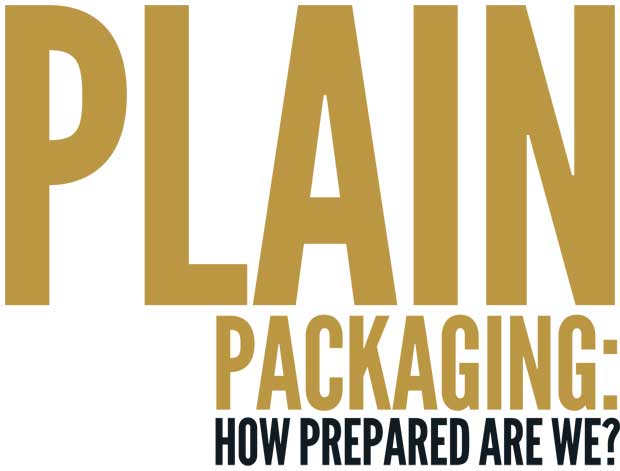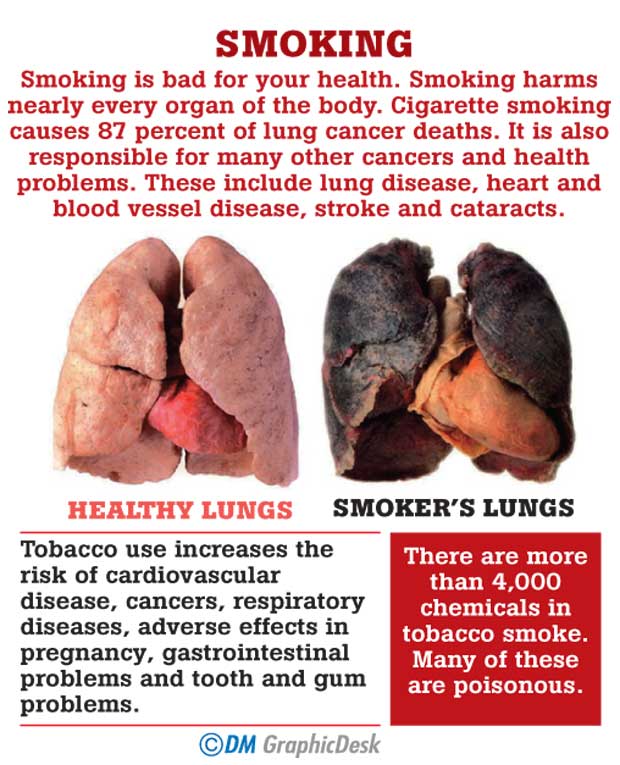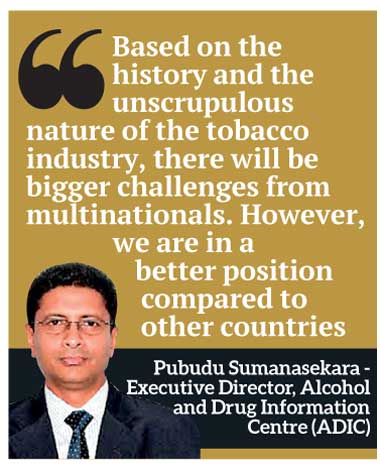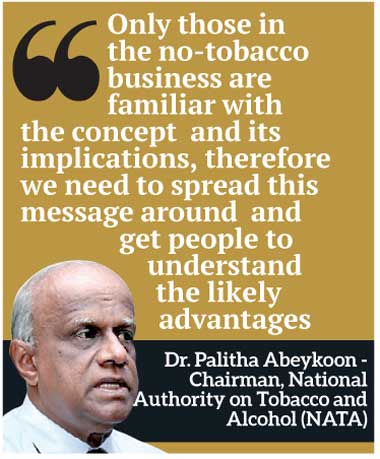Reply To:
Name - Reply Comment
Last Updated : 2024-04-19 00:10:00

 warnings, tax stamps and other government-mandated information or markings; prescribed font style and size; and standardized shape, size and materials. There should be no advertising or promotion inside or attached to the package or on individual cigarettes or other tobacco products.” In December 2012, Australia became the first country to implement fully, tobacco plain packaging. France, Ireland and the United Kingdom of Great Britain and Northern Ireland have all passed laws requiring implementation of plain packaging from May this year. To delve into Sri Lanka’s position on plain packaging and challenges which need to overcome at policy level, the Daily Mirror spoke to several authorities committed to the cause.
warnings, tax stamps and other government-mandated information or markings; prescribed font style and size; and standardized shape, size and materials. There should be no advertising or promotion inside or attached to the package or on individual cigarettes or other tobacco products.” In December 2012, Australia became the first country to implement fully, tobacco plain packaging. France, Ireland and the United Kingdom of Great Britain and Northern Ireland have all passed laws requiring implementation of plain packaging from May this year. To delve into Sri Lanka’s position on plain packaging and challenges which need to overcome at policy level, the Daily Mirror spoke to several authorities committed to the cause.
 illing around six million people a year, the tobacco epidemic is one of the biggest public health threats which plague the world. While more than five million of these deaths are the result of direct tobacco use, more than 600,000 are the results of non-smokers being exposed to second-hand smoke. As the WHO (http://www.who.int/) further points out, nearly 80% of the more than one billion smokers live in low and middle-income countries where the burden of tobacco-related illnesses and deaths is heaviest. Moreover, these tobacco smokers who die prematurely deprive their families of income, raise the cost of healthcare and hinder economic development.
illing around six million people a year, the tobacco epidemic is one of the biggest public health threats which plague the world. While more than five million of these deaths are the result of direct tobacco use, more than 600,000 are the results of non-smokers being exposed to second-hand smoke. As the WHO (http://www.who.int/) further points out, nearly 80% of the more than one billion smokers live in low and middle-income countries where the burden of tobacco-related illnesses and deaths is heaviest. Moreover, these tobacco smokers who die prematurely deprive their families of income, raise the cost of healthcare and hinder economic development.
This year’s theme of ‘No Tobacco Day’ which is ‘plain packaging’ envisages several objectives according to the WHO: reducing the attractiveness of tobacco products, eliminating the effects of tobacco packaging as a form of advertising and promotion, addressing package design techniques that may suggest that some products are less harmful than others and increasing the noticeability and effectiveness of health warnings.

The challenges which remain before us in moving towards plain packaging are several; the concept itself is something new to both policy makers and the public. “Only those in the no-tobacco business are familiar with the concept and its implications, therefore we need to spread this message around and get people to understand the likely advantages,” asserts the Chairman, National Authority on Tobacco and Alcohol (NATA), Dr. Palitha Abeykoon. He maintains that Public Health Warnings (PHWs) with the plain packaging (without the brand and the attractive presentation of the boxes) will further reduce the appeal of the package which is one of the reasons for the lesser appeal it has for youth.
The second challenge in championing this concept is the litigation the tobacco industry will initiate. “The industry will take the government and NATA to court, as they have done in a number of other countries and of course these tobacco companies have lost in all cases. Australia, UK and many South American countries are fine examples. All these countries are implementing plain packaging. Therefore the process can be delayed and cause distractions which need to be overcome,” maintains Dr. Abeykoon.

Fighting to implement plain packaging in Sri Lanka implies a battle with the world tobacco industry, not just the local tobacco industry, their agents and advocates, points out the Executive Director, Alcohol and Drug Information Centre (ADIC), Pubudu Sumanasekara. “Although the Minister of Health issued the gazette notification on August 8, 2012, notifying the enforcement of pictorial warnings to protect children, youth, women, non-smokers and even smokers in our country, it took three and a half years to finally establish PHWs in Sri Lanka. So based on the history and the unscrupulous nature of the tobacco industry, there will be bigger challenges from multinationals.” However, we are in a better position compared to other countries, observes Mr. Sumanasekara who attributes it to some proactive individuals found at policy making level. “However, we still have the challenge of convincing policy makers and politicians in relevant authorities.”
Among tobacco demand reduction approaches, raising taxes on tobacco is the most effective policy  to reduce tobacco use and save lives. WHO global estimates show that ‘if taxes were increased by 50% per pack, governments would earn an extra 101 billion US dollars in revenue which could be channelled towards combating cancers, cardiovascular diseases and other non- communicable diseases. If all countries increased the amount of excise tax they charged on cigarette packs by 50%: there would be 49 million fewer smokers and at least 11 million smoking-attributable deaths would be averted’.
to reduce tobacco use and save lives. WHO global estimates show that ‘if taxes were increased by 50% per pack, governments would earn an extra 101 billion US dollars in revenue which could be channelled towards combating cancers, cardiovascular diseases and other non- communicable diseases. If all countries increased the amount of excise tax they charged on cigarette packs by 50%: there would be 49 million fewer smokers and at least 11 million smoking-attributable deaths would be averted’.
Here at home, cigarette prices have not increased compared to essential goods according to affordability and inflation over many years, observes the ADIC Executive Director who cites a study conducted by Verité Research. This study reveals that the price of a John Player Gold Leaf cigarette, which has the largest market share (over 83%)maintains the same level of affordability as it had been from 1980 to 2000. Had the prices been adjusted since 2000 in keeping with GDP per capita, the price of a stick as of 2014, should have been Rs. 47 although it was priced at Rs. 28.
“Considering the local taxation context, it can be observed that there is no consistency of tax rates between the various lengths of cigarettes. Moreover, the total tax share on retail price has been less than the recommended minimum of 75%. The loss due to the combined effect of under-pricing and under taxation is estimated to exceed 20 billion in 2013 which was twice as much as what was spent on Samurdhi benefits,” points out the ADIC Executive Director. According to ADIC studies, even users prefer price increases as that supports quitting. “Recently phone tax rates increased by 15% and the government is expecting Rs. 12,815 billion.
This money could have been easily collected without burdening the majority of the population if alcohol and tobacco taxes were increased by 1.2%,” observes Sumanasekara.
World research shows that 30% of the legal tobacco industry’s profit is fuelled by illegally smuggled ‘legal cigarettes’. “So cigarette smuggle is part of the so called legal tobacco industry. From time to  time they raise issues regarding smuggled cigarettes allegedly claiming that price or tax increases on legal cigarettes (although cigarettes are under-priced in Sri Lanka) results in an increase in smuggled cigarettes. The tobacco industry tactically utilizes smuggled cigarettes to improve their own profits,” says Sumanasekara. Similar to the alcohol industry which says that increase in the price of legal alcohol increases illicit alcohol consumption, the same argument is used by tobacco companies, he asserts.“The tobacco company claims that increasing cigarette prices would result in increased floods of products such as beedi in the market. This is a not true. Beedi use is fading out from society and it is not attractive to the youth. This beedi issue is exaggerated by the tobacco company.”
time they raise issues regarding smuggled cigarettes allegedly claiming that price or tax increases on legal cigarettes (although cigarettes are under-priced in Sri Lanka) results in an increase in smuggled cigarettes. The tobacco industry tactically utilizes smuggled cigarettes to improve their own profits,” says Sumanasekara. Similar to the alcohol industry which says that increase in the price of legal alcohol increases illicit alcohol consumption, the same argument is used by tobacco companies, he asserts.“The tobacco company claims that increasing cigarette prices would result in increased floods of products such as beedi in the market. This is a not true. Beedi use is fading out from society and it is not attractive to the youth. This beedi issue is exaggerated by the tobacco company.”
As the NATA Chairman explains, we have just concluded a conference on illicit tobacco and have signed the Illicit Tobacco Protocol of the Framework Convention. We are in fact the first in South East Asia to do so. “Now we are in a position to share more information on illicit tobacco and smuggling of cigarettes. The problem is that sometimes it is the tobacco industry itself that does the smuggling to derive benefits from the government, to keep the prices low.
This often happens a few months before the budget session.”
It is imperative for the civil society including the media to be more proactive on the issue of tobacco and smoking. This public health problem has a heavy toll on the national economy as well as the state health sector, not forgetting the fact that the burden of tobacco-related illnesses and deaths is  heaviest in middle income and low income countries. “It must be recalled that the role media have played in the past decade is one primary reason why we have achieved so much and in the current situation media should be the vehicle of promoting the message that quitting tobacco is possible and that it is never too late to quit. A life-long smoker will be a non-smoker in physiological terms if he quits for a period of five years. His/her body will revert to near normal,” points out Dr. Abeykoon. Expressing similar sentiments, ADIC Executive Director urges media to be ‘change agents’ who could push policy makers and politicians to formulate and implement effective tobacco tax policies in the country without becoming pawns in the hands of multinationals such as tobacco. “We can see from past experiences that whenever policy makers, politicians are ignorant, the civil society took the leadership and worked towards implementing public health policies such as tobacco control initiatives. Media can play a significant role in mobilizing civil society to act against ruthless strategies and interferences of the unscrupulous tobacco industry.”
heaviest in middle income and low income countries. “It must be recalled that the role media have played in the past decade is one primary reason why we have achieved so much and in the current situation media should be the vehicle of promoting the message that quitting tobacco is possible and that it is never too late to quit. A life-long smoker will be a non-smoker in physiological terms if he quits for a period of five years. His/her body will revert to near normal,” points out Dr. Abeykoon. Expressing similar sentiments, ADIC Executive Director urges media to be ‘change agents’ who could push policy makers and politicians to formulate and implement effective tobacco tax policies in the country without becoming pawns in the hands of multinationals such as tobacco. “We can see from past experiences that whenever policy makers, politicians are ignorant, the civil society took the leadership and worked towards implementing public health policies such as tobacco control initiatives. Media can play a significant role in mobilizing civil society to act against ruthless strategies and interferences of the unscrupulous tobacco industry.”
Shedding light upon the psychological impact of less attractive packaging and pictorial health warnings, Consultant Psychiatrist, National Hospital of Sri Lanka and Senior Lecturer, Faculty of Medicine, University of Colombo, Dr. Mahesh Rajasuriya explains that the principle of ‘Conditioning’ found in Psychology is employed by the advertising agencies. “What conditioning means, when you associate one stimulus with a pleasant stimulus, you start feeling pleasant about the first stimulus. In terms of the tobacco industry and its advertising, it is depicted that smokers have more female attraction. Theoretically, the same principle can be used to make a person feel unpleasant about a certain stimulus as well. Less attractive packing and pictorial health warnings could give a negative message which would make a smoker feel unpleasant about buying cigarettes.”
Empirically, however, as the Consultant explains, we do not have local research findings. Yet countries such as Australia have notable research findings to confirm that smokers find cigarettes less appealing with such moves, he says. “Some smokers have even reported a decline in taste and the good news is that imitating smoking has also dropped notably.”
What makes it difficult for a smoker to quit is tri-pronged: physical, psychological and social. Nicotine contained in cigarettes is addictive and as Dr. Rajasuriya explains, tobacco companies over the years have ‘mastered the habit of delivering nicotine’. Psychologically, smokers associate certain lifestyle behaviours such as using the toilet or reading a newspaper with smoking. Socially, it is the image one builds up as a smoker, the fact that there is an expectation from others to smoke. “the tobacco industry plays a huge role in all these three domains. Very often tobacco companies sponsor quitting help lines and websites which paint the picture that quitting is a daunting task, which is not so,” says the psychiatrist, who also notes that the tobacco industry advertises not only through formal means but also through informal channels, placing the product in unsuspecting locations such as in movies.
Interestingly many smokers quit without professional help. “Other than a minority, many quit with the influence and support of their immediate network such as friends and families. Although there is medication to help mitigate withdrawal symptoms such as anxiety, irritability, lack of concentration, these symptoms last only for a couple of days,” explains the psychiatrist.

Add comment
Comments will be edited (grammar, spelling and slang) and authorized at the discretion of Daily Mirror online. The website also has the right not to publish selected comments.
Reply To:
Name - Reply Comment
On March 26, a couple arriving from Thailand was arrested with 88 live animal
According to villagers from Naula-Moragolla out of 105 families 80 can afford
Is the situation in Sri Lanka so grim that locals harbour hope that they coul
A recent post on social media revealed that three purple-faced langurs near t